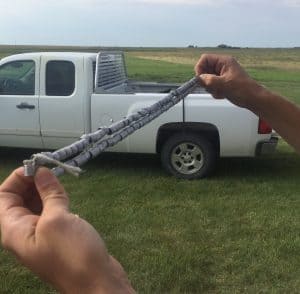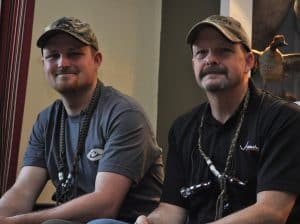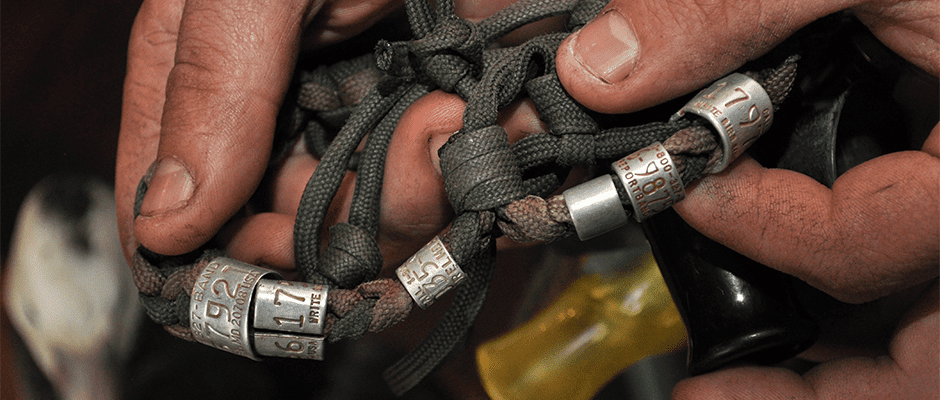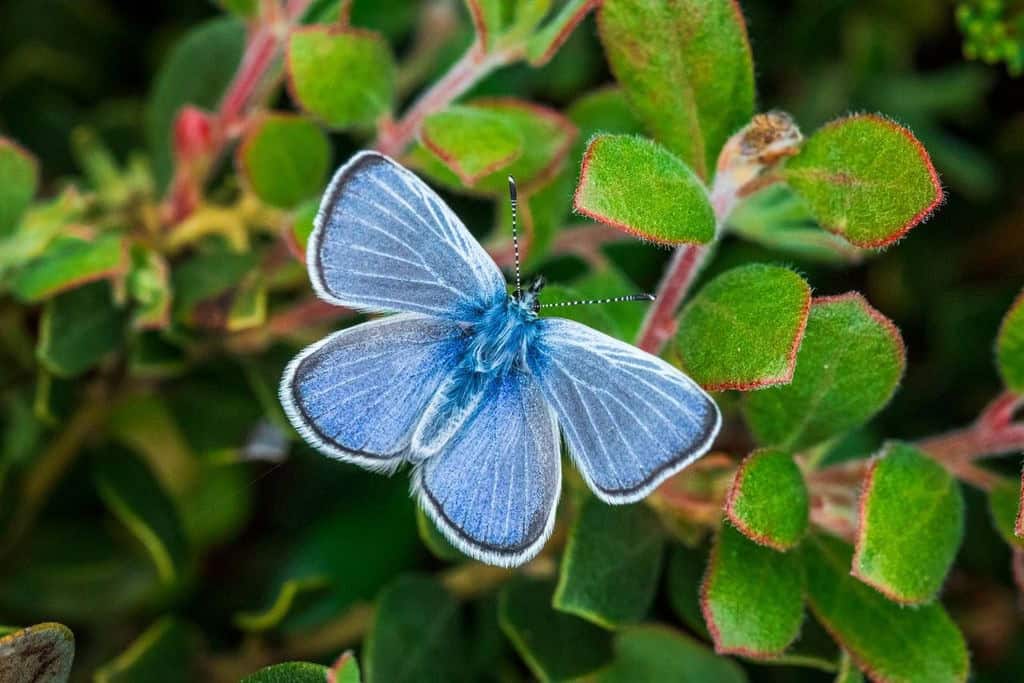Share this article
Bird bling contributes to waterfowl management
With a cobalt blue, cloud-filled sky overhead, Sacramento Fish and Wildlife Office Biologist Vincent Griego set out on a 30-minute bumpy ride through the prairies of Saskatchewan, Canada — just outside of Saskatoon. Surrounded by green and brown fields of barley and canola, with the distinct earthy smell of wetlands and a choir of sandhill cranes overhead, Griego and three United States Fish and Wildlife Service colleagues representing regions throughout the country made the trek to this remote location for the Service’s annual duck-banding event.
The Western Canada Cooperative Waterfowl Banding Program is a long-term, large-scale banding program. This joint effort involves the Service, Canadian Wildlife Service, state and provincial wildlife management agencies, Flyway Councils, First Nations, and non-governmental waterfowl advocacy and research organizations. Commencing in the early 1950s, the program is critical to successful wildlife management. “This program is important to give our best estimates of the status of migratory waterfowl and it ensures that the ducks can be sustainable in the future,” said Griego. “It helps to establish hunting regulations, so that way these species can maintain their populations. It provides opportunities for people like me to hunt, or to take photos, or to appreciate the wild.”

Biologists band more than 200,000 ducks and nearly 150,000 geese and swans in North America each year. ©Vincent Griego, USFWS
The teams work throughout the month of August, a time when the climate fluctuates between comfortably cool and nearly 100 degrees. The days are long — on average, biologists spend 11 hours in the field every day to band as many birds as possible. Banding is a complex process that requires intense focus, patience, a steady hand and an advanced knowledge of waterfowl. The trapping sites are typically the same every year, strategically selected to maximize the capture of most waterfowl, with priority species being mallard (Anas platyrhynchos) and Northern pintail (Anas acuta). Working in teams, biologists set up and bait portable “swim-in” 8 foot x 8 foot welded wire-mesh traps that minimize injury to the birds. Each is baited with barley purchased from local farmers. The barley is placed in the water and on Styrofoam floats that are topped with a piece of plywood, which provides the ducks a place to rest and dry off. Traps are placed 30 feet from the shore to reduce the likelihood of coyotes, raccoons, and mink capitalizing on easy prey.
To expedite the ducks’ release, 24-hours after setting and baiting the traps, the biologists return to the site. The birds are transferred to a 3 foot x 2 foot “catch box,” which is positioned against the swim-in traps and allows the birds to swim into the catch box on their own. Each catch box can hold up to 97 birds depending on the species. After transfers have been made, the catch box is transported to the shoreline where the ducks are banded. A biologist then begins the process of data collection — documenting the bird’s species, age and sex on data sheets. The data are later entered into U.S. and Canadian databases for tracking. More than just ducks make their way into the traps. Coots, gulls, and other non-target species are promptly released without banding.
Each duck is handled by one biologist through the species identification, banding and release process. Ducks are removed from the catch boxes one-by-one. After noting the duck’s species and sex, the biologist positions the duck so its feet are facing outward, making it easier to apply the appropriate-size metal bands — each with a unique nine-digit numeric code. With the bird in one hand and an aluminum band in the other, the biologist uses pliers to carefully close the band. The application technique takes patience and precision — apply too much pressure and the ends of the band will overlap, affixing too tightly on the duck’s leg. Apply too little pressure and the band will not close completely, leaving a gap that can get clogged with debris, causing another hazard for the bird. Both ends of the band have to be flush and align evenly. Once banded, the ducks are released into the wind away from the upland area to reduce their risk of becoming prey. The entire process from swim-in trap retrieval to release takes approximately 10 to 15 minutes.

Wyatt Milne (left) was introduced to hunting by his father Sean (right) at age five. Twenty years later, the pair are still hunting partners. ©Veronica Davison, USFWS
Peak migration begins in late September, with ducks flying south from Canada to the U.S. and beyond. Throughout their journey, the U.S. Geological Survey and Canadian Wildlife Service Bird Banding Office receive reports of banded bird encounters, which helps document their movements, longevity and sources of mortality. Reports come from many sources, including hunters. They make an important contribution to conservation each time they report an encounter with a banded duck, as those data are used to help determine appropriate hunting regulations each year.
Describing his first encounter with a banded duck, 25-year-old hunter Wyatt Milne said, “I was with my old man at Colusa National Wildlife Refuge . . . I remember jumping around and yelling in the pond, yelling with excitement. It’s a badge of honor — not everybody’s got one.” Milne’s father introduced him to the sport of hunting when he was five years old. Twenty years and eight bands later, he still hunts with his father, mostly on National Wildlife Refuges in California and several other states. Milne has a deep respect for wildlife and a keen understanding of his role in the nation’s conservation efforts. “We always try to educate non-hunters in the sense that what we’re doing is not bad, we’re not just out there killing everything that flies around. There’re limits, there’s regulations. We do this for a reason — it’s to conserve what we have.”
Last year, 30,747 ducks were banded including mallards, Northern pintail, blue-winged teal (Anas discors), and redheads (Aythya Americana). This is an increase over the 27,672 banded in 2015. The success of this program is a testament to U.S.-Canadian partnership. According to Kerry Hecker, protected areas manager for Environment and Climate Change Canada —Canadian Wildlife Service, “birds migrate and travel and live on a continental scale. They don’t just live in one state, one county, one province . . . If we weren’t managing on a continental scale, we wouldn’t be able to do anything cohesive, coherent, and useful.” The partnership is unique in its scope and the myriad levels at which the effort is coordinated. “It’s absolutely essential for the two countries to work together and I think we’ve managed that at a very good and grassroots level, as well as at the upper legislative, administrative, and overall agreement level. The biologists that come up from the U.S. Fish and Wildlife Service are very competent, capable, and easy to get along with.”
Conservation requires the involvement of government, organizations, and individuals to ensure success. With nearly seven decades of experience through this bi-lateral partnership, the Service and the Canadian Wildlife Service have jointly managed a program that engages landowners, hunters, and others to better understand waterfowl and ensure their survival.
Learn more about waterfowl banding by clicking on these links.
Bird Banding
Reporting Banded Birds
Flyways.us
The U.S. Fish and Wildlife Service is a Strategic Partner of TWS.
Header Image: Wyatt Milne has harvested eight banded ducks, six of them are displayed on his lanyard. ©Veronica Davison, USFWS








